
We are not all one, Mr. Genki Sudo. We endeavor to pacify the perils of discord by chiseling different elements into a more defined order. It's human nature to tirelessly evaluate everything and establish a rigid hierarchy, even if we've beaten the JMMA horse to death so thoroughly that its lifeless corpse has already been consumed and expelled by Alistair Overeem or processed into a bottle of Elmer's.
Superficial or not, the Sengoku, Shooto and TKO featherweight champion will dictate the pivotal next step of his homeland's combat sports reputation. While Hatsu Hioki has all the talent and potential to spark a historical revival, George Roop also has all the tools to snuff out another overseas star.
Or, if you're like me, this is simply two game and exciting mixed martial artists with fifteen minutes to kick each other's asses and demonstrate their superiority on that night and that night only. Hioki's already proven his esteem by twice defeating the UFC's last number one contender, Mark Hominick (once by triangle), and top-ranked featherweights Masanori Kanehara and Marlon Sandro.
George Roop (12-71) vs. Hatsu Hioki (24-4-2)
One advantage Hioki will have over some of his past counterparts is signing with the UFC while still in his prime. At age twenty-eight and currently surfing on a four-fight win streak, the "Child of Shooto" also took up training at the renowned Tristar Gym with Georges St. Pierre under Firas Zahabi in June.
Excluding three appearances in Canada's longstanding TKO promotion, Hioki's entire career transpired in Japan. Acclimating himself with a reputable camp to the oft-unfamiliar characteristics of a cage versus a ring, the addition of forearm and elbow strikes, and the unified rules and scoring system shows a very promising awareness.
Gifs and analysis in the full entry.
SBN coverage of UFC 137: Penn vs. Diaz
Though no slouch in the striking department, Hioki's ground game is downright murderous and Roop will clearly look to keep this fight standing. I suggest reviewing two technical articles to supplement this analysis: Tomas Rios' breakdown of Hioki's grappling wizardry against Marlon Sandro in Sengoku and the Judo Chop of Roop's takedown defense and front push kick against Josh Grispi.
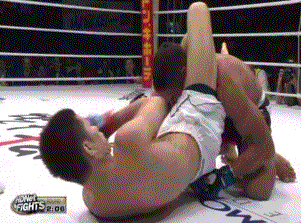
http://i43.tinypic.com/oro0e9.jpg
With half of his wins coming by way of submission, Hioki is a straight up machine on the mat.
All of his catches have been some combination of triangle and/or armbar save one rear-naked choke and one submission via strikes.
The unfortunate and barely discernible victim engulfed in Hioki's octopus-like limbs to the right is former Sengoku and current Bellator featherweight Ronnie Mann.
What differentiates Hioki's venomous ground assault is the way he simultaneously ties every possible advantage together for unparalleled efficiency: technique, position, intelligence, leverage, defense and striking.
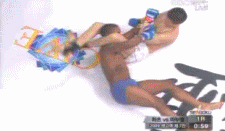
http://i43.tinypic.com/rlb66f.gif
This next clip depicts that theme perfectly.
It begins with Hioki securing the triangle and looking like he's about to fall back on the mat.
Showing unreal core strength and tactical brilliance, he shifts his momentum forward while posting his right arm and torquing his hips over.
The control he has over his opponent's head and shoulders is just like being locked in a medieval stockade. Hioki's application of leverage lands him in the mounted triangle position where he bombs punches and finishes with the armbar.
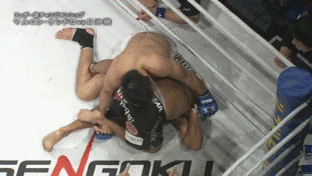
Hioki is billed as only a brown belt, but look no further than the artful mastery he rattled off on Sandro to win the Sengoku title.
Bear in mind, Sandro is a black belt under Andre Pederneiras at Nova Uniao; a facility jam-packed with prestigious, multiple-time world champion grapplers.
After sprawling on a Sandro takedown attempt, Hioki goes "two-on-one" wrist control to snatch a hammerlock, keeps the arm trapped with one hand and then snakes his now-free arm around Sandro's back, hooking his right ankle and sweeping into north-south.
From SnarkFights.com, Tomas Rios walks us through the final animation with a concise assessment:

With north/south position now secured, Hioki uses Sandro's desperation to pull his arm out of the hammerlock against him by converting the hold into a kimura.
The transition is an easy one since the moment Sandro's arm is longer stuck behind his back an opening is created for the kimura to be applied. Luckily for Sandro he still has the strength to straighten his arm out just enough to keep Hioki from finishing the technique. However, doing so only allows Hioki to transition into a straight armbar.
The key factor in this sequence is that Hioki maintains position throughout. His legs and hips are pinning down Sandro's head and left shoulder which eliminates any chance of Sandro initiating a scramble since he once again can't move his upper body. Although Hioki is unable to finish either of the submissions he attempts, the dominant position he worked so hard to achieve remains in place. This is a testament to his innate talent for staying one step ahead on the mat at all times. Technically, Sandro's only mistake thus far has been over-pursuing a takedown, but it's a mistake that has been exponentially exploited every step of the way.
The transition is an easy one since the moment Sandro's arm is longer stuck behind his back an opening is created for the kimura to be applied. Luckily for Sandro he still has the strength to straighten his arm out just enough to keep Hioki from finishing the technique. However, doing so only allows Hioki to transition into a straight armbar.
The key factor in this sequence is that Hioki maintains position throughout. His legs and hips are pinning down Sandro's head and left shoulder which eliminates any chance of Sandro initiating a scramble since he once again can't move his upper body. Although Hioki is unable to finish either of the submissions he attempts, the dominant position he worked so hard to achieve remains in place. This is a testament to his innate talent for staying one step ahead on the mat at all times. Technically, Sandro's only mistake thus far has been over-pursuing a takedown, but it's a mistake that has been exponentially exploited every step of the way.
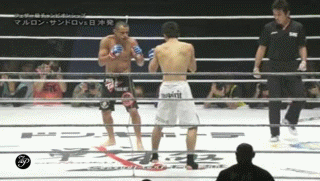
http://1.bp.blogspot.com/_XgUh-2vXAbs/TSvEExMs9TI/AAAAAAAAANI/MLjWkKfloGw/s1600/2.gif
We're at a stage in the sport's evolution where belt color takes a backseat to technical adaptation, and Hioki is the creme of the crop in the latter.
He's also enhanced his stand up from wholly functional to "holy shit!" with tight boxing and high kicks.
Capitalizing on his lengthy reach by keeping opponent's on the end of his punches and a general clean up in his footwork and stance highlight Hioki's most noticeable strides.
His beard is proven with decisions (three split, one unanimous) accounting for all four of his career losses.
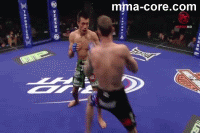
http://i56.tinypic.com/34q2sk7.jpg
George Roop is an under-rated fighter.
A natural featherweight, Roop competed as a lightweight on the reality show where he defeated BJJ black belt Rolando Delgado and John Polakowski (with a broken hand) before Phillipe Nover submitted him in the semifinals.
Post-TUF, he beat Dave Kaplan and accepted a fight with eventual top-tenner George Sotiropoulos on short notice, once again losing via submission.
Dropping back down to 145, he took a fight outside the UFC and became the Rage in the Cage featherweight champion with a decision over Matt Dell.
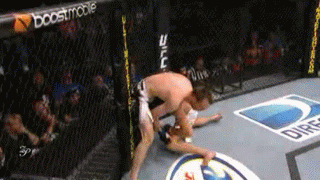
Signing up with the WEC, Roop got a little carried away and plummeted all the way down to 135-pounds, looking thoroughly drained and emaciated in a decision loss to the venerable Eddie Wineland.
Back to 145 again, his victory over Leonard Garcia was sabotaged by a shady point deduction for a low blow, which altered the outcome to a draw.
Roop then achieved what no mortal has ever done, even in training: he separated The Korean Zombie, Chan Sung Jung, from consciousness (above).
In his last two, Roop suffered his first TKO loss to Mark Hominick and upset Josh Grispi in arresting fashion.

http://2.bp.blogspot.com/-2aNKId492aE/TerPneluIPI/AAAAAAAADKI/7ZjwcIELGkU/s1600/2.gif
The Grispi fight ended up as a rather one-sided affair with Roop's ultra-sturdy takedown defense and stiff striking carrying him to victory.
In the clip above, the thorny barrage of short elbows while stuffing the shot were just one of many technical fronts he's developed, leaving Grispi nothing to deal with but his long and feisty kickboxing.
To the left, Roop hammers Grispi with a knee to the body, which still stands as a seriously under-utilized resource in North American MMA.
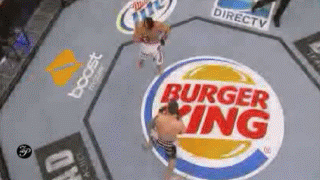
http://2.bp.blogspot.com/-mLI3T1NLml0/TerPpnPkf_I/AAAAAAAADKQ/E87UXPHd2QY/s1600/4.gif
His bag of tricks also included a crisp front kick to keep Grispi at bay.
Here Roop plants the kick square to the solar plexus and sends Grispi sailing to the canvas.
The linear travel of the strike offers nice coverage of distance and makes it tough to do much other than avoid.
Roop also laid out some surprising scrambling abilities, getting back to his feet quickly in the instances he was taken down, and pounced hard on every opportunity.

http://1.bp.blogspot.com/-7QzErRxSTCg/TerPosQTlOI/AAAAAAAADKM/yVtyZxlzxi4/s1600/3.gif
Warding off Grispi's advance into the clinch -- which is how Hioki pursues takedowns -- Roop showers with punches and engages him on the ground rather than back off safely.
He cleaved a series of sharp elbows from inside Grispi's guard but made sure he had an escape route at all times and never over-committed.
Though Grispi and Hioki are incomparable on the ground, I still enjoyed Roop's surging confidence and willingness to battle (albeit briefly) outside of his comfort zone.

The final aspect that stood out was the monstrous body shot he finished Grispi with (below).
It was easily Roop's best performance to date for many reasons. His overall fundamentals were not only sharper than ever, but ideally tailored to shield his weaknesses and exploit his strengths.
Hioki, however, is an entirely different animal. It's best for Roop to treat him with Aoki-like concern and frantically avoid his clutches on the ground, in any position or magnitude and at all costs.
Not a traditional freestyle or Greco Roman wrestler, most of Hioki's takedowns are initiated in the clinch with throws and trips from the body lock. Instead of letting an all-or-nothing double leg fly from a distance, he methodically closes range behind a hail of long punches and cuts short, precise angles into tie-ups.
Roop does an excellent job of defending this by cramming underhooks and keeping a wide, low base with his hips back and against the fence, splashing in the aforementioned elbows to the head as an additional deterrent.
My summary is that the gap in skill, technique and experience is vast in Hioki's favor everywhere but standing, where he can match Roop much better than Roop can on the mat. Knowing Hioki will run things on the floor, Roop's footwork and Hioki's striking -- the key to unlocking his advantage -- should dictate this match.
While an an upset is plausible, Hioki is simply not one-dimensional. He's more likely to engage Roop on the feet emphatically and catch him with punches or work his clinch toward a takedown, where few can withstand his prowess.
My Prediction: Hatsu Hioki by submission
Poll George Roop vs. Hatsu Hioki
- George Roop
- Hatsu Hioki


